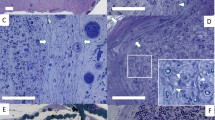Abstract
Background
Entrapment of the middle cluneal nerve (MCN), a peripheral nerve in the buttock, can elicit low back pain (LBP). We examined the epidemiology, clinical course, and treatment of MCN entrapment (MCN-EN).
Methods
Among 383 LBP patients who visited our institute, 105 were admitted for intractable LBP. They were 42 men and 63 women; their average age was 64 years. Based on clinical symptoms, palpation, and the effects of MCN block, we suspected MCN-EN in these 105 patients, 50 of whom are our study subjects. Their treatment outcomes were assessed at the time of discharge and at follow-up visits.
Results
MCN-EN was diagnosed in 50 of the 383 patients (13.1%) and they were hospitalized. In 43 (11.2%), MCN-EN was associated with other diseases (superior cluneal nerve entrapment, n = 21, sacroiliac joint pain, n = 9, other, n = 13). At the time of discharge, the symptoms of patients with LBP due to MCN-EN were significantly improved by repeat MCN blocks. In 7 of the 383 patients (1.8%), LBP was improved by only MCN blocks; 5 of them had reported leg symptoms in the dorsal part of the thigh. After discharge, 22 of the 50 hospitalized patients required no additional treatments after 2–5 blocks; 19 required only conservative treatment, and 9 underwent microsurgical release of the MCN.
Conclusions
We confirmed MCN-EN in 50 of 105 patients admitted for intractable LBP. Repeat MCN blocks were effective in 22 patients; 19 required additional conservative treatment, and 9 underwent surgery. Buttock pain radiating to the posterior thigh was an MCN-EN symptom that has been diagnosed as pseudo-sciatica. Before subjecting patients with intractable LBP to surgery, the presence of MCN-EN must be ruled out.



Similar content being viewed by others
References
Deyo RA, Weinstein JN (2001) Low back pain. N Engl J Med 344:363–370
Kuniya H, Aota Y, Kawai T et al (2014) Prospective study of superior cluneal nerve disorder as a potential cause of low back pain and leg symptoms. J Orthop Surg Res 9:139
Maigne JY, Doursounian L (1977) Entrapment neuropathy of the medial superior cluneal nerve. Nineteen cases surgically treated, with a minimum of 2 years’ follow-up. Spine (Philadelphia, PA 1976) 22:1156–1159
Morimoto D, Isu T, Kim K et al (2013) Surgical treatment of superior cluneal nerve entrapment neuropathy. J Neurosurg Spine 19:71–75
Konno T, Aota Y, Saito T et al (2017) Anatomical study of middle cluneal nerve entrapment. J Pain Res 10:1431–1435
Aota Y (2016) Entrapment of middle cluneal nerves as an unknown cause of low back pain. World J Orthop 7:167–170
Matsumoto J, Isu T, Kim K et al (2018) Surgical treatment of middle cluneal nerve entrapment neuropathy - Technical note. J Neurosurg Spine 29:208–213
Kim K, Isu T, Matsumoto J et al (2018) Low back pain due to middle cluneal nerve entrapment neuropathy. Eur Spine J 27(Suppl 3):309–313
Strong EK, Davila JC (1957) The cluneal nerve syndrome; a distinct type of low back pain. Ind Med Surg 26:417–429
Fujihara F, Kim K, Kokubo R, Isu T, Miki K, Morimoto D, Iwamoto N, Inoue T, Morita A (2020) High-frequency thermal coagulation to treat middle cluneal nerve entrapment neuropathy. Acta Neurochir (Wien). https://doi.org/10.1007/s00701-020-04404-8
Isu T, Kim K, Morimoto D et al (2018) Superior and middle cluneal nerve entrapment as a cause of low back pain. Neurospine 15(1):25–32
Matsumoto J, Isu T, Kim K et al (2019) Middle cluneal nerve entrapment mimics sacroiliac joint pain. Acta Neurochir (Wien) 161(4):657–661
Aota Y, Kuniya H, Konno T et al (2014) Cluneal nerve: [Entrapment of the superior/middle cluneal nerves can cause leg pain and/or tingling, and may mimic lumbo-sacral spinal disorders]. J Spine Res 5(6):951–955 (in Japanese)
Kuniya H, Aota Y, Nakamura N et al (2011) Low back pain patients with suspected entrapment of the superior cluneal nerve. J Spine Res 2(6):1032–1035
Trescot AM (2003) Cryoanalgesia in interventional pain management. Pain Phys 6(3):345–360
Konno T, Aota Y, Kuniya H et al (2017) Anatomical etiology of “pseudo-sciatica” from superior cluneal nerve entrapment: a laboratory investigation. J Pain Res 10:2539–2545
Ermis MN, Yildirim D, Durakbasa MO et al (2011) Medial superior cluneal nerve entrapment neuropathy in military personnel; diagnosis and etiologic factors. J Back Musculoskelet Rehabil 24:137–144
Kim K, Isu T, Chiba Y et al (2015) Treatment of low back pain in patients with vertebral compression fractures and superior cluneal nerve entrapment neuropathies. Surg Neurol Int 6(Suppl 24):S619–S621
Revel M, Poiraudeau S, Auleley GR, Payan C, Denke A, Nguyen M, Chevrot A, Fermanian J (1998) Capacity of the clinical picture to characterize low back pain relieved by facet joint anesthesia. Proposed criteria to identify patients with painful facet joints. Spine (Phila Pa 1976). 23:1972–1976
Murakami E, Aizawa T, Noguchi K et al (2008) Diagram specific to sacroiliac joint pain site indicated by one finger test. J Orthop Sci 13:492–497
Kurosawa D, Murakami E, Aizawa T (2015) Referred pain location depends on the affected section of the sacroiliac joint. Eur Spine J 24:521–527
Author information
Authors and Affiliations
Corresponding author
Ethics declarations
Conflict of interest
The authors declare that they have no conflicts of interest.
Ethical approval
All procedures were in accordance with the ethical standards of the institutional and/or national research committee and with the 1964 Helsinki declaration and its later amendments or comparable ethical standards. Our study was approved by the institutional ethics committee of Kushiro Rosai Hospital.
Informed consent
Informed consent was obtained from all patients included in this study.
Additional information
Publisher’s note
Springer Nature remains neutral with regard to jurisdictional claims in published maps and institutional affiliations.
This article is part of the Topical Collection on Peripheral Nerves
Rights and permissions
About this article
Cite this article
Fujihara, F., Isu, T., Kim, K. et al. Clinical features of middle cluneal nerve entrapment neuropathy. Acta Neurochir 163, 817–822 (2021). https://doi.org/10.1007/s00701-020-04676-0
Received:
Accepted:
Published:
Issue Date:
DOI: https://doi.org/10.1007/s00701-020-04676-0




